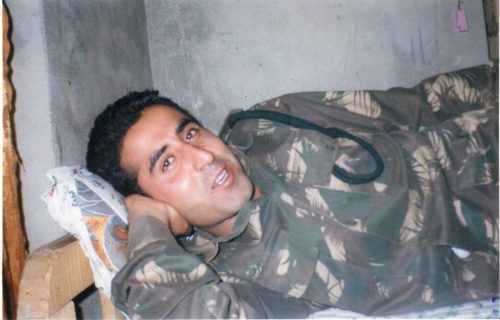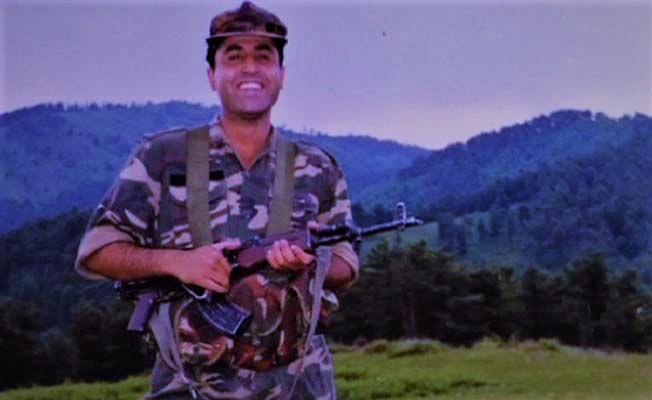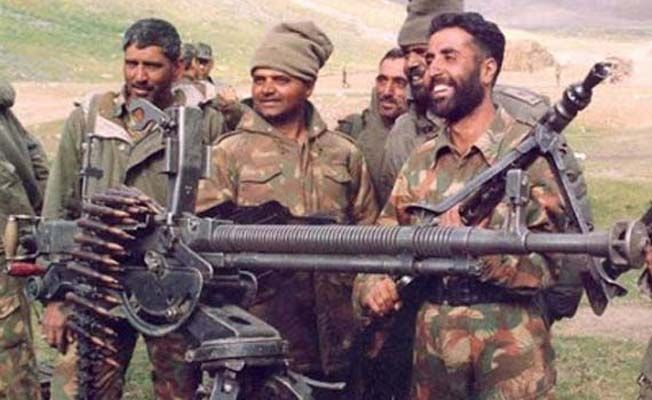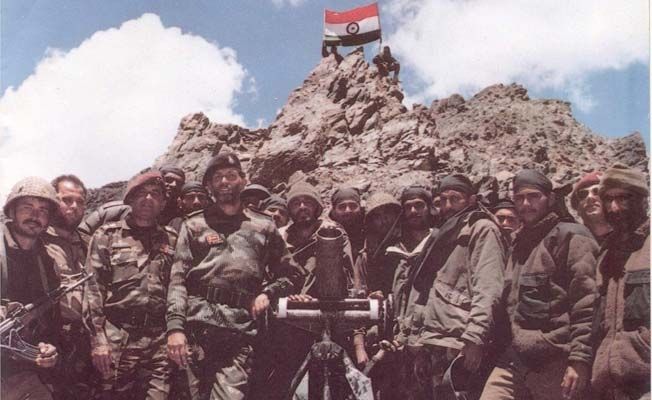Sher Shah of Kargil: The Story of Indian Army Legend, Captain Vikram Batra
Actor Siddharth Malhotra will be portraying the role of Captain Vikram Batra, the legendary Sher Shah of Kargil, in an upcoming biopic.

“Our flag does not fly because the wind moves it, it flies with the last breath of each soldier who died protecting it.” – Author Unknown
On July 26, 1999, the Indian Armed Forces won a gritty and decisive war against Pakistan. In the ferocious battle, many brave young soldiers laid down their lives defending their nation on the inhospitable battlefield of Kargil.
It’s been more than eighteen years since then, but the unparalleled courage and sacrifice of Kargil heroes are still etched in the collective memory of the country. Among these many bravehearts was a man who would become the face of every young Indian soldier who fought ferociously and died fearlessly.
This is the story of Param Vir Chakra Vikram Batra, the unbelievably courageous soldier whose actions in the battlefield transcended heroism.

Born on September 9, 1974, in Himachal Pradesh, Vikram Batra spent his childhood in the beautiful mountain town of Palampur. The elder of twin sons ( he was born 14 minutes before his brother Viahal), he was the third child of Girdhari Lal Batra, a government school principal, and Kamal Kant, a school teacher.
Immensely popular among his classmates and teachers, Vikram was an all-rounder at school — brilliant at studies, he was also a keen sportsman and avid participant in co-curricular activities. Adjudged the best NCC cadet of north India, he was also a green belt holder in karate and played table tennis at national level.
Deeply patriotic from a young age, Vikram was always keen on joining the Army. So it was no surprise to his family when he decided to prepare for Combined Defense Services (CDS) examination after completing his Bachelor’s degree in 1995. Interestingly, he had been selected for a job in the merchant navy by a Hong Kong based firm but he ultimately changed his mind, telling his mother,
“Money is not everything in life; I have to do something bigger in life, something great, something extraordinary, for my country.”
A decade later, his decision would be paid a tribute in an Indian Oil print campaign that lauded him for rejecting a lucrative career for the service of the nation.
“Sometimes an ordinary Indian can make a Rs 120,000 crore company feel humble. For every step we take, there’s an inspired Indian leading the way”, read IOC’s ad copy, alongside a etched black-and-white image of Captain Batra.

In 1996, his dream was fulfilled when he cleared the CDS examination with flying colours and joined the Indian Military Academy where he was commissioned as a lieutenant. His first posting was in the town of Sapore in Jammu and Kashmir’s Baramulla district.
In 1999, when Kargil War broke out, Vikram had just completed a Commando Course at Belgaum and got leave to celebrate Holi with his family at his home Palampur. Like he always did when he returned home, he headed to Neugal Cafe (a local riverside eatery) for a cup of coffee with his friend.
“The war has begun, who knows when you will be asked to go, you better be careful.”
“Don’t worry. I’ll either come back after raising the Indian flag in victory or return wrapped in it, but I will come for sure”, was Vikram’s reply to his friend’s concerned words.
Soon after, Vikram’s unit received orders to move to Kargil and he reported for duty on June 1, 1999. Eighteen days later, on June 19, 1999, he was ordered to recapture Point 5140 in his first major battle in the war.
In spite of the enemy having the advantage of height, Vikram and his men led a brilliant tactical assault on the enemy. The enemy camp was routed, their soldiers killed and 13 J&K Rifles won a decisive victory that strengthened India’s hold on the territory (and would later lead to the fall of Tiger Hill, and to India’s eventual victory).
Elated that all his men had made it alive, Vikram famously told his commander at the base — “Ye Dil Maange More” — using the popular slogan of Pepsi’s ad campaign to express his desire to do more. The photo of the young captain, laughing besides an anti-aircraft gun snatched from Pakistani soldiers, also went on to become the most enduring image of India’s first televised war.

Vikram’s father will never forget the phone call he got on the morning of June 20. It took him a while to understand his son’s unclear words, crackling through a satellite phone.
“Daddy, I’ve captured the enemy’s post. I’m OK, I’m OK.”
“Beta, I’m proud of you. May God bless you to carry on your task”, replied the relieved father, reveling in the accomplishment of his brave son who had lived up to his name.
Nine days later, Vikram called from base camp before leaving for another crucial operation. He told his worried parents, “Ek dum fit hoon, fikar mat karna (I’m absolutely fine. Don’t you worry.)”. That was the last time he spoke to them.
Vikram’s next operation was one of the most difficult mountain warfare campaigns undertaken during Kargil – the capture of the 17000 feet high Point 4875. The icy slopes of this peak were 80 degree steep (made even more precarious by the thick fog) and Pakistani troops had positioned themselves at the height of 16000 feet.

On the night of July 7, Vikram and his men began their tortuous climb to fortify the Indian force which was already fighting the invaders at 16,000 feet. The enemy got wind that the formidable Sher Shah (Vikram’s code name) had arrived and and intensified their attack, raining mortar and automatic fire from above. They knew who Sher Shah was — by then, the young captain’s military prowess had become the stuff of legend on both sides.
Vikram counter-attacked ferociously, supported ably by his friend and fellow officer, Anuj Nayyar, Engaging in hand-to-hand combat, clearing enemy bunkers and egging their men forward, the two bravehearts forced the shocked enemy to retreat.

The mission was almost over when a junior officer injured his legs in an explosion. As Vikram rushed out of the bunker to rescue him, his subedar begged him not to go and said he would go instead. But Vikram told him: “Tu baal-bacchedar hain, hat ja peeche.” (You have children, step aside)”.
Under heavy fire, he hurled grenades at the enemy’s machine gun post and killed five soldiers in close combat while moving towards the injured lieutenant. He had just reached and was lunging to lift his mate when he was hit by a bullet in his chest.
Mortally wounded, Vikram passed way after completing the mission in a manner that etched his name him alongside some of India’s greatest military heroes. His comrade in battle, Captain Anuj Nayyar, had also died while clearing enemy bunkers. By morning, India had recaptured Peak 4875 (now called Vikram Batra Top) but lost two of her bravest sons.
At Vikram’s funeral, his grief-stricken mother said, “Maybe there was a reason why God gave me twins — one he had marked for the country and one for me.”

Today, a statue of her son adorns the town square of Palampur, across the statue of another legendary soldier — Major Somnath Sharma, India’s first Param Vir Chakra awardee, who also belonged to Palampur.
“The enemy is only 50 yards from us. We are heavily outnumbered. We are under devastating fire. I shall not withdraw an inch but will fight to the last man and the last round”, said Major Sharma, before he laid down his life battling enemy raiders during the Indo-Pak war of 1947.
His towering legacy couldn’t have found a worthier successor than Captain Vikram Batra, the swashbuckling soldier who gave a nation its war cry and a generation of youngsters their motto.
For his sustained display of the most conspicuous personal bravery and leadership of the highest order in the face of the enemy, Captain Vikram Batra was posthumously awarded Param Vir Chakra — India’s highest award for gallantry in battle. Captain Anuj Nayyar was awarded the Maha Vir Chakra — the nation’s second highest honour.
Also Read: The Little Known Story of Major Somnath Sharma, India’s First Param Vir Chakra Recipient
Like this story? Or have something to share? Write to us: [email protected], or connect with us on Facebook and Twitter.
NEW: Click here to get positive news on WhatsApp!
If you found our stories insightful, informative, or even just enjoyable, we invite you to consider making a voluntary payment to support the work we do at The Better India. Your contribution helps us continue producing quality content that educates, inspires, and drives positive change.
Choose one of the payment options below for your contribution-
By paying for the stories you value, you directly contribute to sustaining our efforts focused on making a difference in the world. Together, let’s ensure that impactful stories continue to be told and shared, enriching lives and communities alike.
Thank you for your support. Here are some frequently asked questions you might find helpful to know why you are contributing?


This story made me
-
97
-
121
-
89
-
167













